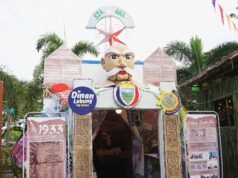SCIENCE CITY OF MUÑOZ – A ONE-HECTARE of rice land is not capable of supporting the needs of a farmer’s family if it is used for mono-culture of rice.
A farmer is lucky if he gets a net of from P20,000 to P30,000 per cropping per hectare. Moreover, the cash money comes only when the harvest is sold.
At harvest time, the farmer will have to make clean of his obligations that include his loan (three cavans for every P1,000), irrigation service fee, and some other obligations. Almost always, he ends up with little profit from his rice land and his is a cycle of backbreaking toil that sees little hope for a better life.
Even if he uses his farm for two rice production cycles, the income wouldn’t be enough for the family.
The Philippine Rice Research Institute (PhilRice) here has a model on how to make the most out of a hectare of land. It is called the “Palayamanan” system.
“Monoculture of rice in one hectare is indeed not enough to support the needs of a family of five,” the PhilRice said in explaining the importance of this system. “The Palayamanan system can help the farmers earn more,” it added.
“Palayamanan” is a coined word from two Tagalog words which are palay (rough rice) and “kayamanan” (wealth).
It is now adopted in many parts of the country.
Key concept
The key concept in this system is a high level of integration, PhilRice said.
“It combines rice with other high-value crops and trees, fish, poultry, livestock, and biomass recycling. It espouses efficient use of available farm resources and highlights the interconnectivity between each resource and by-product through modern available technologies,” said the PhilRice in explaining how the system works.
It is an old paradigm, even immortalized in the song Bahay-Kubo which lost its popularity because of the widespread application the rice-rice culture.
The benefits that the system can provide include the following: continuous food supply, higher income and economic stability, increased farm productivity and sustainability, reduced production risk, maximized use of land or better resource allocation, and enhanced diversity and ecological imbalance.
The land can be subdivided as follows: residential area which can be used for a farmhouse or hut, nursery, vegetable garden, animal production area, and waste recycling area; field crop production area for rice production, rice-fish culture and continuous cash crop production; small farm reservoir area for freshwater fish culture and water catchments, and fruit and vegetable trees areas.
Based on studies conducted, “Palayamanan” can provide almost daily cash flow and the family is assured of abundant supply of nutritious food in their everyday meals.
The net income in Palayamanan is more than double than that which monoculture of rice provides.
Strategy
Rizal Corales, in-charge of the project, said the farmers can consider the following guides in adopting the Palayamanan system:
For crops: plant about half a hectare with rice, plant one row of taro along the perimeter of the rice area and along the canals, and grow on the bunds vegetables.
For cash crops and vegetable production: plant a variety of crops to reduce pest damage and price fluctuation, plant high value crops or cash crops such as onion, melon, cucumber, squash, and corn during the dry season and off-season vegetables such as tomato, eggplant, pepper, string beans, bitter gourd, sponge gourd, and or okra during the wet season, and plant open pollinated vegetable varieties to ensure continuous supply of seeds.
The farmer, Corales said, should construct raised plots for vegetable growing during the rainy season, put up trellises for creeping vegetables, wrap hanging vegetables to protect them from insects, cover the vegetable garden with a fine mesh net, and plant green leafy vegetables such as mustard and lettuce for cash money at a shorter time.
Different kinds of fruit and vegetable trees can also provide good income for the family in due time.
Livestock can give big income as well as value to farm biomass and household discards. Raising fowls such as ducks and chicken can provide immediate cash while goats, sheep and pigs can cover intermediate expenses. Large animals such as cows and carabaos can be a source for major household expenditures.
A multi-animal single roof system can be used for raising two cows, 10 goats, 10 pigs, 50 chicken, and 50 ducks. Mulch beddings of rice hull, coco dust, sawdust, chopped rice straw, and dried leaves mixed with carbonized rice hull and garden soil is recommended for reduced cleaning. The animal bedding can be used as organic fertilizer later on.
For aquaculture, grow tilapia, hito and bulig. For the rice-fish culture area, construct a pond refuge along one of the rice area’s perimeter and release the fingerlings after transplanting rice.
For biomass waste recycling, the rice straw, weeds, and plant trimmings can be used as feed supplement for animals. The household wastes such as vegetable peelings and food leftovers and farm biomass can be turned into compost or feed supplement, Corales said.
Corales said the PhilRice, in coordination with local government units (LGUs), is giving seminar-training on how best to adopt this model.
Benefits
The benefits that can be derived from applying the concept of Palayamanan can be categorized into two. These are the non-cash benefits and the cash benefits.
The non-cash benefits are continuous food supply for the family, reduced production risks, savings and healthy diet from eating home-grown crops, and savings from converting biomass wastes into fertilizers.
The cash benefits showed this net income per year: For rice, P15,045; onion, P17,200; corn (green), P5,250; vegetables, P14,847; two cycles of rice-fish and gabi farming, P37,205; and two cycles of raising 20 chicken and five pigs, P11,666 or a total of P101,213.
Not yet included in the study are the expected incomes from crops and animals raised in the farm such as cow, goat, sheep, bananas, fruits, and others.
Corales said more than 100 farmers in different parts of the country have adopted the Palayamanan system.
“Based on feed backs, they are very much satisfied about their project. We are expecting many more will follow suit,” Corales said.




